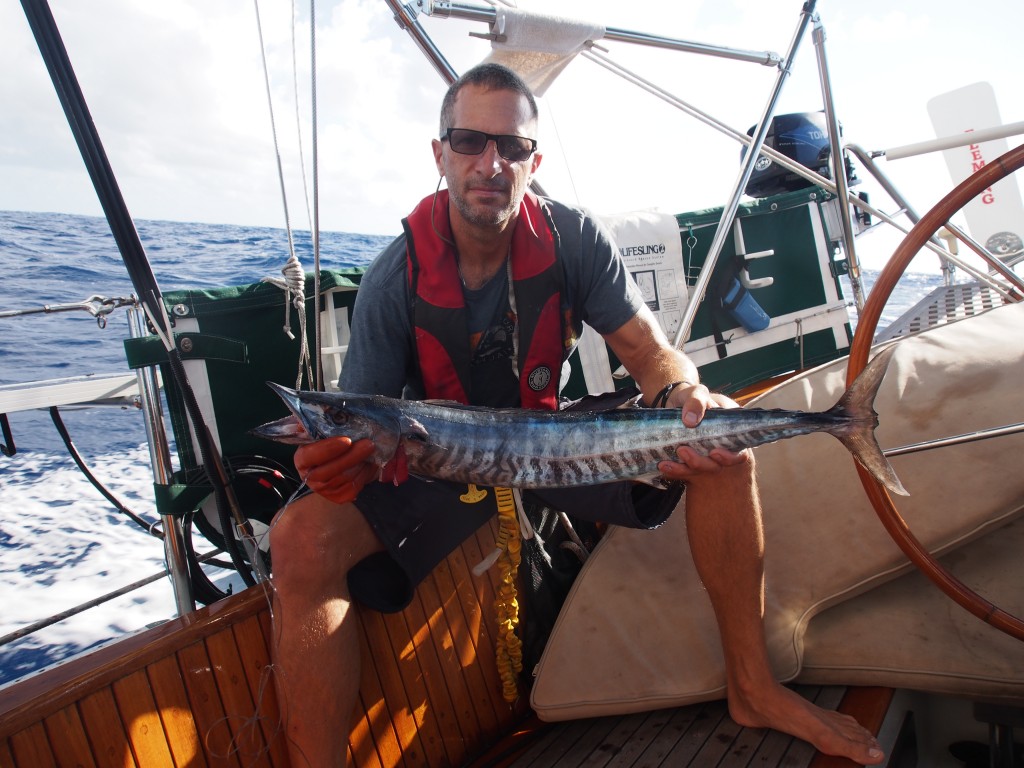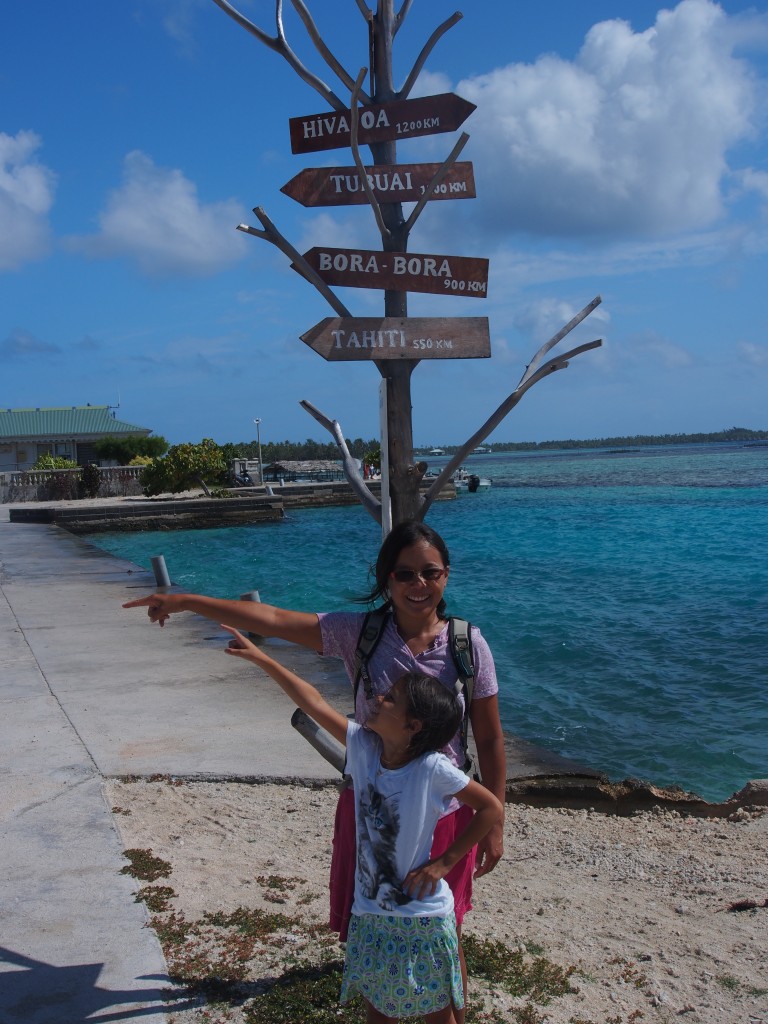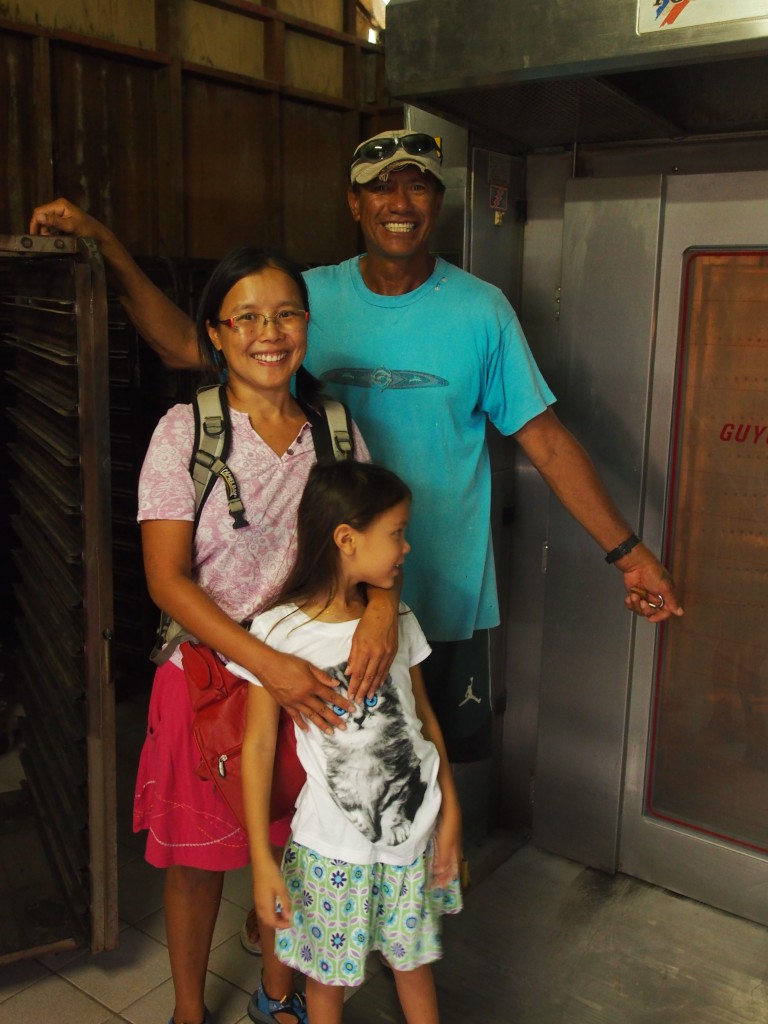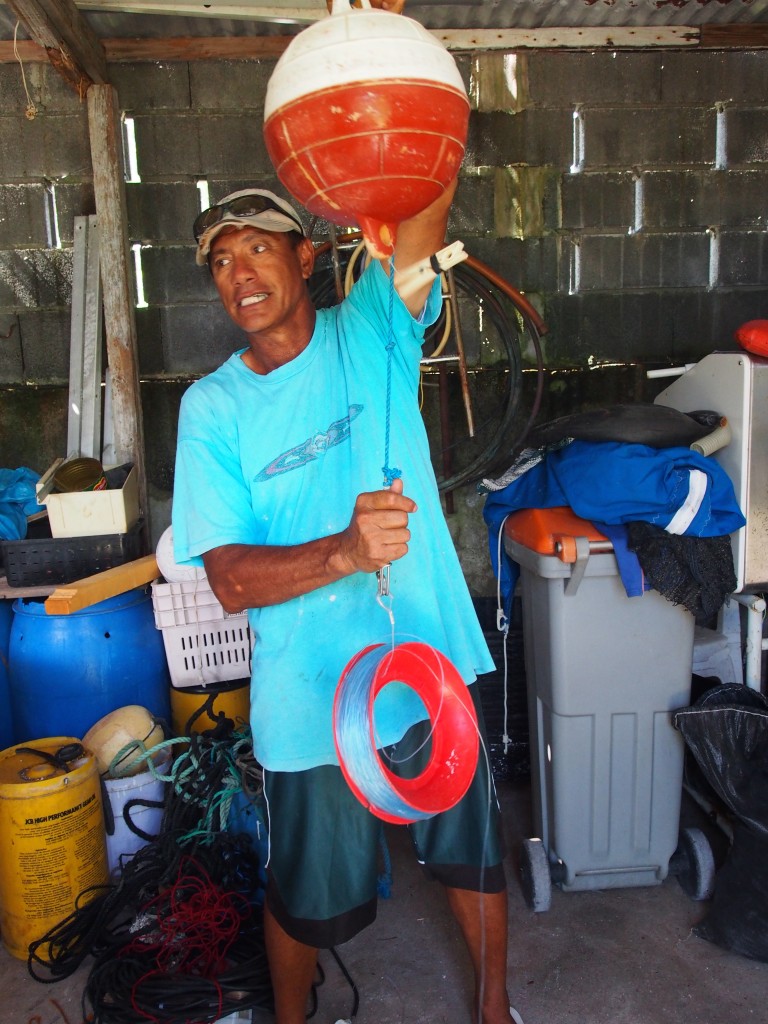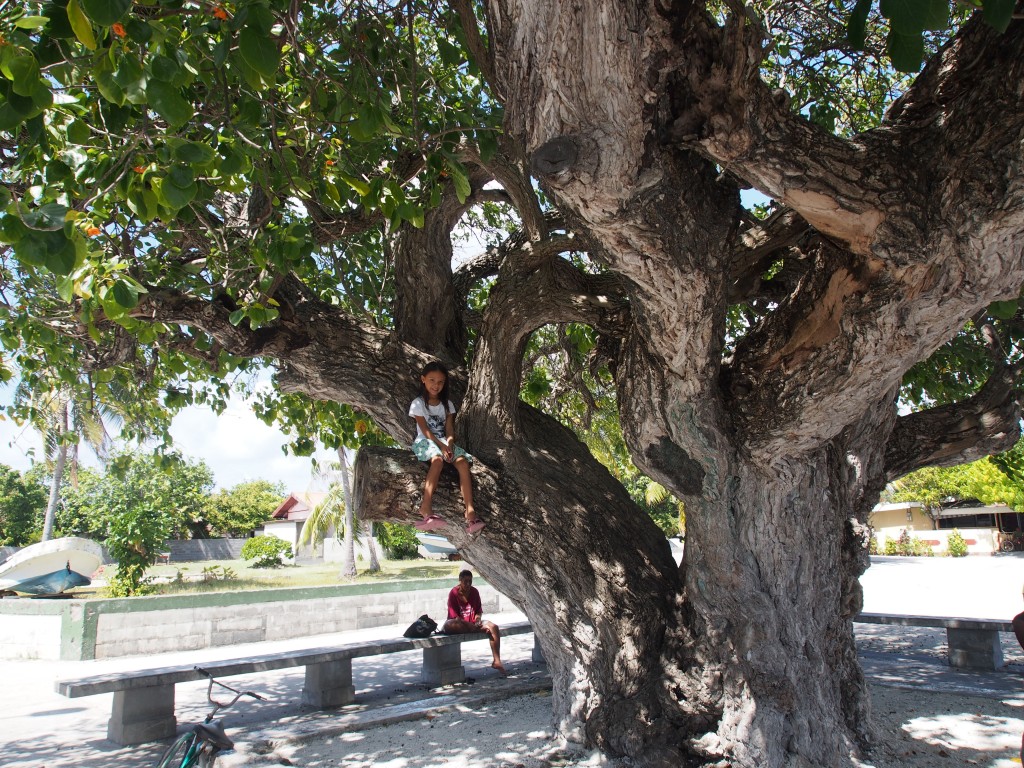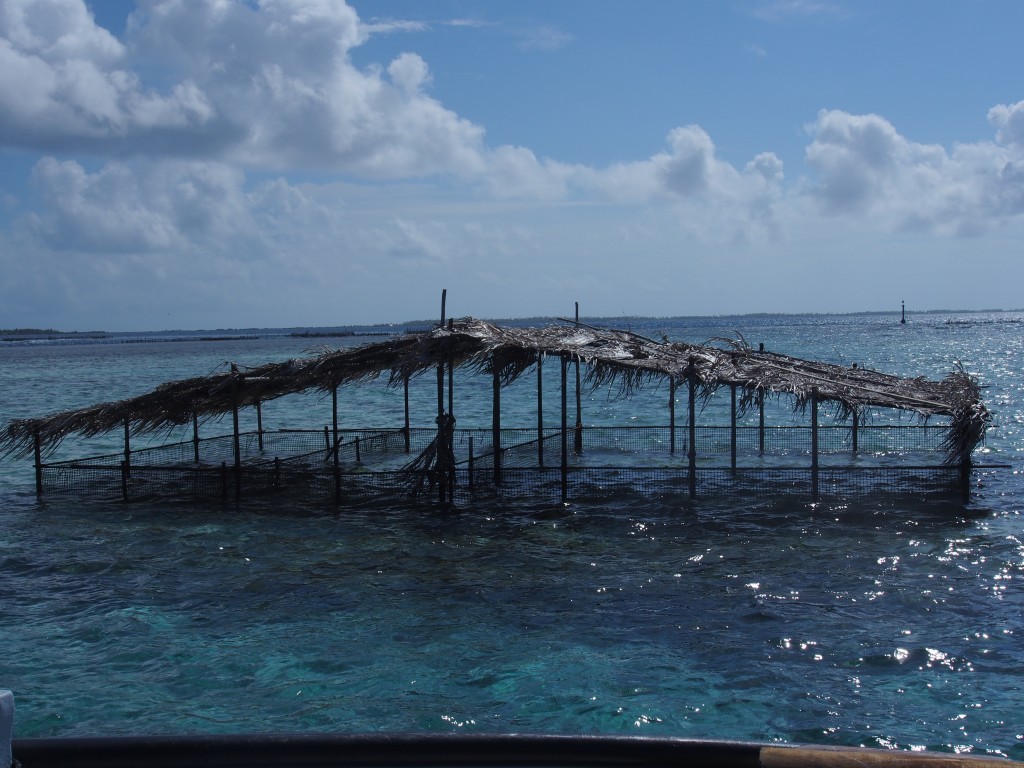[pin 4320] Hi from Apropos in the Tuamotus. After 18 wonderful days in the Marquesas, visiting 4 of the islands, we up-anchored and sailed towards the Manihi atoll in the Tuamotus. The passage took 3 days, 4 hours and covered 499 miles. We broke our best 24-hour distance-covered-record during the Pacific Puddle Jump crossing by 2 miles–162 nm on day 3. The passage was more tiring with just two of us on watch, but we managed well. We sailed the entire way with winds averaging 15 knots on a beam reach. The first 2 nights we sailed through squalls with winds reaching 25 knots. Seas were 4-6′ on the beam, so as usual, cooking or doing anything down below was difficult. I pulled in a 30″ Barracuda on a hand line in the morning of day 2, so we had a real nice dinner that night. Entering an atoll requires precise timing. Most atolls have 1 or 2 passes and when the tide is going in or out, strong currents flow through them. The best time to transit a pass is during slack (just after high tide or low tide), when current is at a minimum. A few hours before or after slack can make a big difference with current and breaking waves. When you leave on a long, multi-day passage, you try to plan for arriving before a slack time, but many factors influence the actual arrival time–wind, current, sea state. We up-anchored at 8am and knew the passage was 500 miles, so I based our arrival on a 5.0 knt average. This would take 4.2 days and our arrival would be in the late morning so we could transit the pass near noon. 5.0 knt is slow for our boat, but the wind predictions are not usually very accurate and I figured some motoring would be required. An early arrival would just mean waiting at the pass entrance until slack occurred (slack occurs 2-3x per day, but evening times are never good for entering an atoll that has lots of reefs inside). Worst case scenario would be needing to wait outside the atoll overnight if we arrived in the afternoon. Since the winds were stronger than expected, we had a fast passage and averaged a whopping 6.6 knots! This not only cut 24 hours off the passage, but also timed our arrival perfectly, 15 minutes before slack (ok, I admit that was mostly luck, but we hand-steered the final leg to maximize speed). So we motored through the pass at slack with Karen at the helm and me up the ratlines to look for shallow reefs. We had information that said the channel depth at low slack was 8′, so didn’t panic too much when we saw the depth sounder drop to 2′ (measures water depth below the 6′ keel) near the reef crossing. It soon went back up to 30′ and we breathed a sigh of relief. The Manihi atoll is 14 miles long and 5 miles wide. Inside are lots of shallow reefs, and lots of black perl farms. The outer fringe is lined with trees, and a small village is located near the pass entrance on the west fringe. A luxury resort and a small airport are on the north fringe. After anchoring in 60′ of water near the village, we relaxed and got caught up on our sleep. In the following days we will explore the village (there’s a French bakery!) and do lots of snorkeling. This blog update is being done through Sailmail, so pictures will be added once we find wifi…
Daily Archives: May 3, 2015
Manihi Atoll in the Tuamotus
Hi from Apropos in the Tuamotus. After 18 wonderful days in the Marquesas, visiting 4 of the islands, we up-anchored and sailed towards the Manihi atoll in the Tuamotus Archipelago. The passage took 3 days, 4 hours and covered 499 miles. We broke our best 24-hour distance-covered-record during the Pacific Puddle Jump crossing by 2 miles–162 nm on day 3. The passage was more tiring with just two of us on watch, but we managed well. We sailed the entire way with winds averaging 15 knots on a beam reach. The first 2 nights we sailed through squalls with winds reaching 25 knots. Seas were 4-6′ on the beam, so as usual, cooking or doing anything down below was difficult. I pulled in a 30″ Wahoo on a hand line in the morning of day 2, so we had a real nice dinner that night.
Entering an atoll requires precise timing. Most atolls have 1 or 2 passes and when the tide is going in or out, strong currents flow through them. The best time to transit a pass is during slack (just after high tide or low tide), when current is at a minimum. A few hours before or after slack can make a big difference with current and breaking waves. When you leave on a long, multi-day passage, you try to plan for arriving before a slack time, but many factors influence the actual arrival time–wind, current, sea state. We up-anchored at 8am and knew the passage was 500 miles, so I based our arrival on a 5.0 knt average. This would take 4.2 days and our arrival would be in the late morning so we could transit the pass near noon. 5.0 knt is slow for our boat, but the wind predictions are not usually very accurate and I figured some motoring would be required. An early arrival would just mean waiting at the pass entrance until slack occurred (slack occurs 2-3x per day, but evening times are never good for entering an atoll that has lots of reefs inside). Worst case scenario would be needing to wait outside the atoll overnight if we arrived in the afternoon. Since the winds were stronger than expected, we had a fast passage and averaged a whopping 6.6 knots! This not only cut 24 hours off the passage, but also timed our arrival perfectly, 15 minutes before slack (ok, I admit that was mostly luck, but we hand-steered the final leg to maximize speed). So we motored through the pass at slack with Karen at the helm and me up the ratlines to look for shallow reefs. We had information that said the channel depth at low slack was 8′, so didn’t panic too much when we saw the depth sounder drop to 2′ (measures water depth below the 6′ keel) near the reef crossing. It soon went back up to 30′ and we breathed a sigh of relief.
The Manihi atoll is 14 miles long and 5 miles wide. Inside are lots of shallow reefs, and lots of black pearl farms. The outer fringe is lined with trees, and a small village is located near the pass entrance on the west fringe. A luxury resort and a small airport are on the north fringe. After anchoring in 60′ of water near the village, we relaxed and got caught up on our sleep.
Today we explored the village where we met Fernando (we heard about him from our cruising guidebook). He’s full of energy and runs the village bakery that makes 300 baguettes per day and also fishes. He showed us the bakery equipment and explained how the baguettes are made. He also explained how he fishes for Tuna and offered to take me fishing on Friday. Tomorrow he is going spear-fishing on the other end of the atoll and showed us a good spot to anchor there, so we will move the boat 12 miles to the eastern end of the atoll and see him over there. He said the water is clear and snorkeling is great there, so we hope to get in the water and relax on the white-sand beaches there. Right now we’re sitting in his wife’s cafe eating casse croute (baguette with ham, cheese, and egg) and using wifi to update the blog.
We learned that the black pearl farms went out of business about 3 years ago here in Manihi. The market crashed then as China began farming black pearls, glutting the market. Ten years ago the population of Manihi was 1000, and today it’s only about 300. We found the natives to be very friendly and happy people.
